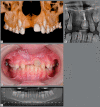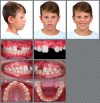Dental autotransplantation as a alternative treatment for the loss of permanent anterior teeth in children
- PMID: 36169499
- PMCID: PMC9507021
- DOI: 10.1590/2177-6709.27.4.e22spe4
Dental autotransplantation as a alternative treatment for the loss of permanent anterior teeth in children
Abstract
Introduction: Autotransplantation is defined as the surgical movement or transposition of a tooth from its original site to a recipient alveolus, in the same patient. It has high success rates when performed within predefined parameters.
Objective: This study aims to describe the advantages of a dental autotransplantation protocol based on a multidisciplinary approach and using cone beam computed tomography, computer-aided planning, and rapid prototyping of the donor tooth, enabling the preparation of a surgical guide and postoperative protective plate. This article discusses the indications and contraindications for autotransplantation, as well as the selection criteria for the tooth to be transplanted and the transoperative care essential for its success. The parameters for post-operative control are described, in addition to the variables of success and failure to be considered.
Conclusions: When analyzing the treatment options available for children with anterior tooth loss and the psychosocial impact on these patients, autotransplantation is considered not only an alternative treatment, but the only viable option for their functional, aesthetic, and social reestablishment.
Introdução:: O autotransplante é definido como a transposição cirúrgica de um dente do seu local original para um alvéolo receptor no mesmo indivíduo, e apresenta altas taxas de sucesso, quando realizado dentro de parâmetros predefinidos.
Objetivo:: O presente estudo tem como objetivo descrever as vantagens de um protocolo de autotransplante dentário baseado em uma abordagem multidisciplinar e utilizando tomografia de feixe cônico, planejamento assistido por computador e prototipagem rápida do dente doador - possibilitando a confecção de um guia cirúrgico e placa protetora pós-operatória. Nesse artigo, serão discutidas as indicações e contraindicações do autotransplante, assim como os critérios de seleção do dente a ser transplantado e os cuidados transoperatórios essenciais para o seu sucesso. Serão descritos os parâmetros para controle pós-transplante, assim como as variáveis de sucesso e insucesso a serem consideradas.
Conclusão:: Ao analisar as opções de tratamento disponíveis para crianças com perdas dentárias na região anterior e o impacto psicossocial nesses indivíduos, deve-se considerar que o autotransplante não se constitui somente em uma alternativa de tratamento, mas sim na única opção viável para o restabelecimento funcional, estético e social desses pacientes, reinserindo-os em seu meio.
Conflict of interest statement
The authors report no commercial, proprietary or financial interest in the products or companies described in this article.
Figures












References
-
- Pacini NM, Nery DT, Carvalho DR, Lima NJ, Jr, Miranda AF, Macedo SB. Dental autotransplant case report. RSBO. 2012;9(1):108–113.
-
- Mendoza Mendoza A, Solano Reina E, Segura-Egea JJ. Treatment of an avulsed maxillary permanent central incisor replaced by autotransplantation of a mandibular premolar 14-year follow-up. Int Endod J. 2010;43(9):818–827. - PubMed
-
- Abella F, Ribas F, Roig M, González Sánchez JA, Durán-Sindreu F. Outcome of autotransplantation of mature third molars using 3-dimensional-printed guiding templates and donor tooth replicas. J Endod. 2018;44(10):1567–1574. - PubMed
-
- Bauss O, Röhling J, Schwestka-Polly R. Prevalence of traumatic injuries to the permanent incisors in candidates for orthodontic treatment. Dent Traumatol. 2004;20(2):61–66. - PubMed
MeSH terms
LinkOut - more resources
Full Text Sources

